
** Darla Travels is reader-supported.
When you buy through our links, we may earn a commission. **
Why walk in Madrid’s parks? Madrid is Spain’s largest city and capital. It’s jam-packed with everything you’d expect in a historic capital: spacious public squares like the Plaza Mayor, shopping on the Gran Via, and world-class art museums. While you’ll want to soak it all in on a visit to Madrid, there may be a limit to the hustle and bustle you’re willing to take.
If you’re tired of crowds and need some relaxation time, don’t worry. Madrid has you covered. A walk in one of the city’s many parks or natural areas, attractions in their own right, will help you recharge and boost your mood. With your energy replenished, you’ll be able to return to your enjoyment of the city. Keep reading to learn where to go in Madrid for a relaxing walk in a natural setting.
- Walk #1: Walking in Madrid’s Parque del Buen Retiro (Retiro Park)
- Walk #2: Walking in the Real Jardín Botánico de Madrid (Royal Botanical Garden of Madrid)
- Walk #3: Strolling the Parque Madrid Río (Madrid River Park) from Matadero to Puente de Toledo
- Walk #4: Exploring the Parque Madrid Río (Madrid River Park) from the Puente Segovia (Segovia Bridge) to Puente del Rey (Bridge of the King).
- Walk #5. An Easy Hike in Casa de Campo Park
- Walk # 6: A Sunday Stroll on the Paseo Del Prado in Madrid
- Where to Stay in Madrid
- A Relaxing Walk in Madrid’s Parks- Pin It for Later!
- Summing up Relaxing Walks in Madrid’s Parks
Walk #1: Walking in Madrid’s Parque del Buen Retiro (Retiro Park)
Madrid’s Retiro Park is an expansive green space that began as a royal retreat. It was created for King Felipe IV in the middle of the 17th century. On 25 July 2021, Retiro Park became part of a combined UNESCO World Heritage Site, the “landscape of light,” which also includes Paseo del Prado, described below.
In the heart of Madrid, this 350-acre (142 ha) green space contains more than 15,000 trees, beautiful gardens, tranquil lakes, grand statues, historic fountains, and oodles of walking paths. While popular with locals, the park is large enough to accommodate everyone, whether walking, running, cycling, or rollerblading.
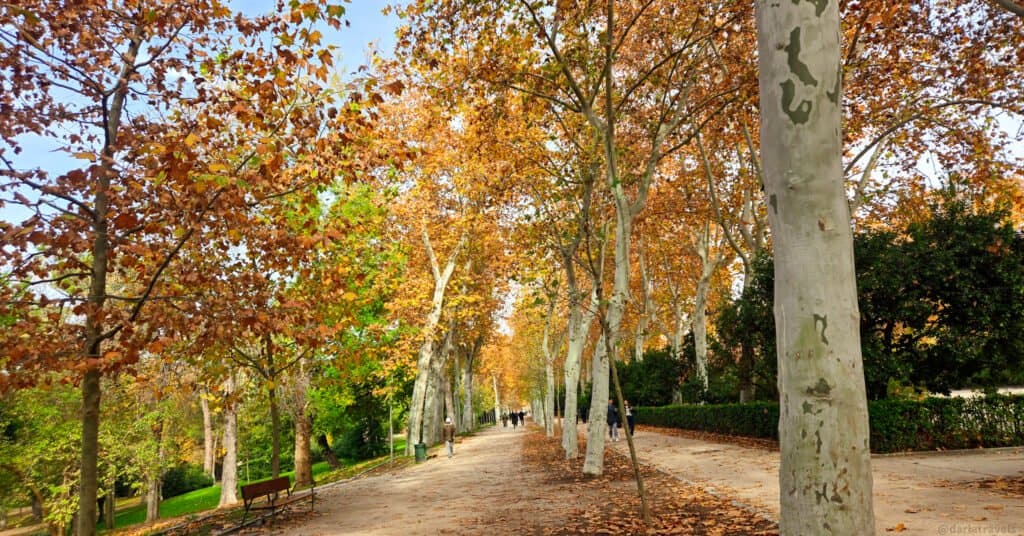
Things to see in Madrid’s Retiro Park
This park has many features to enjoy on leisurely walks. Some of the highlights include:
Estanque del Retiro (Retreat Pond) is an artificial lake near the park’s north edge, built between 1634 and 1636. It once served as a setting for mock naval battles designed to entertain royalty. Today, visitors enjoying the lake on rental boats have an excellent view of the elaborate equestrian Monument to Alfonso XII (Mariano Benlliure, 1902) on the east shore.
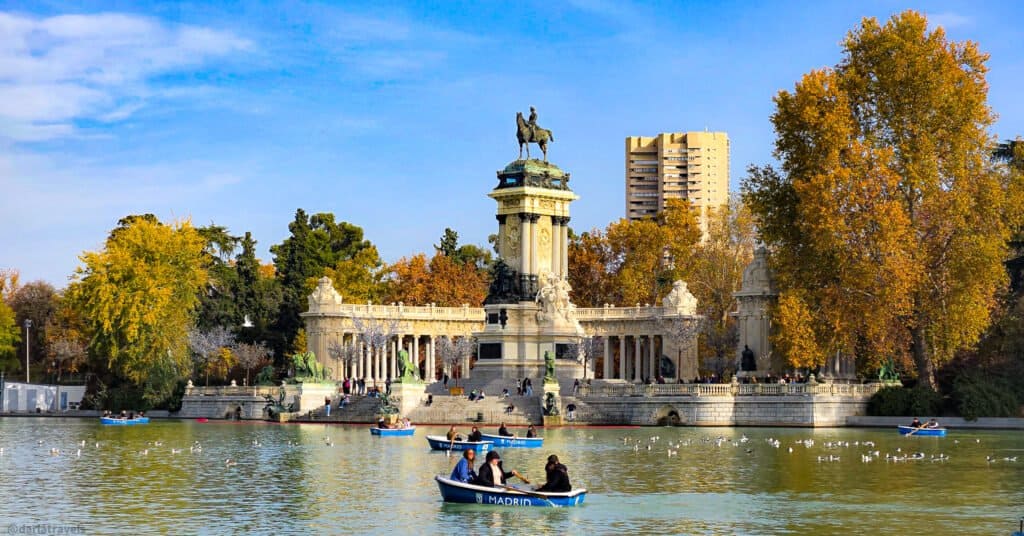
El Retiro Park contains several gardens, each a park within a park. Even on my December visit, the oval Rosaleda, or Rose Garden, had a few roses blooming. And I was delighted by the peacocks in the Jardines de Cecilio Rodríguez.
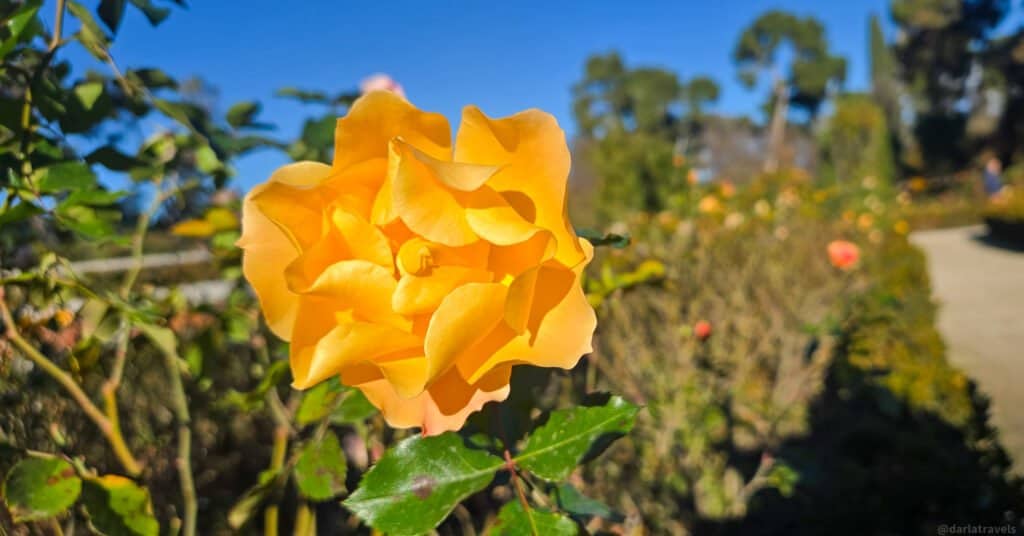
The park’s ornate Crystal Palace, once the home of a “human zoo” exhibition, is now part of the nearby Reina Sofia art museum.
The Eugenio Trías library occupies two large pavilions in the former Casa de Fieras (House of Beasts), Europe’s second exotic animal zoo, which commenced building in 1774 on the orders of King Carlos III. Nearby, the zoo’s former Monkey Pit is now a decorative display.
Retiro Park contains many fountains, but the must-see is the Fountain of the Fallen Angel, topped with a sculpture of El Angel Caído (The Fallen Angel) (Ricardo Bellver, 1878). The statue depicts Lucifer’s exile from Heaven. It’s reportedly the only sculpture in the world dedicated to the devil. Would you believe me if I told you the statue is 666 meters (2,185 feet) above sea level? Well, it’s true!
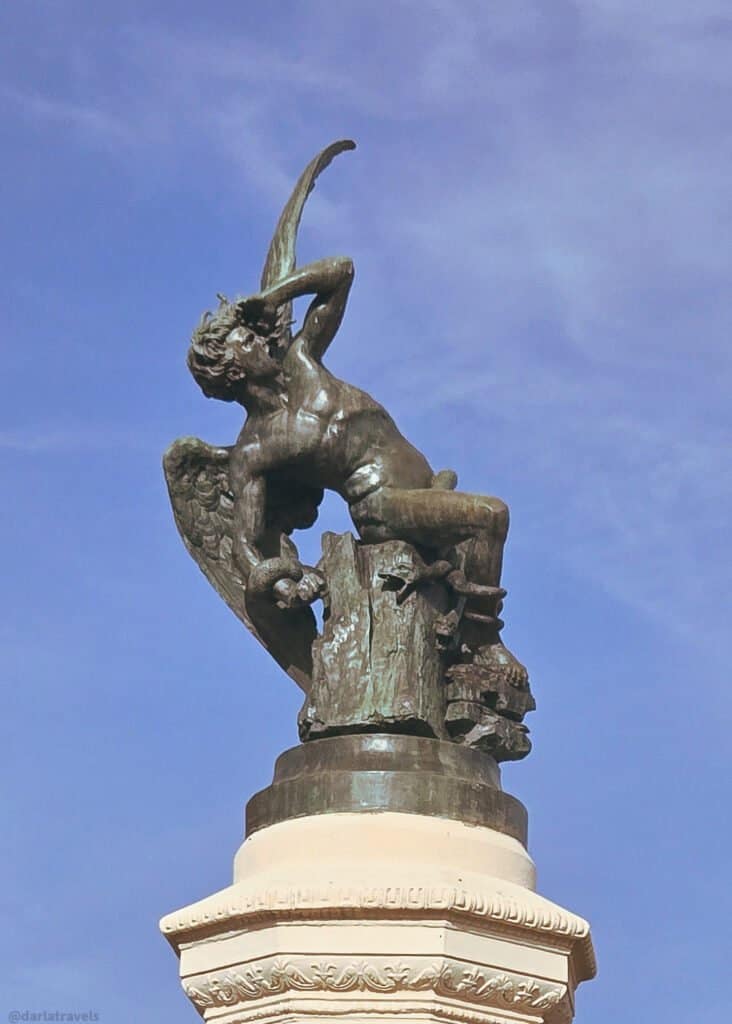
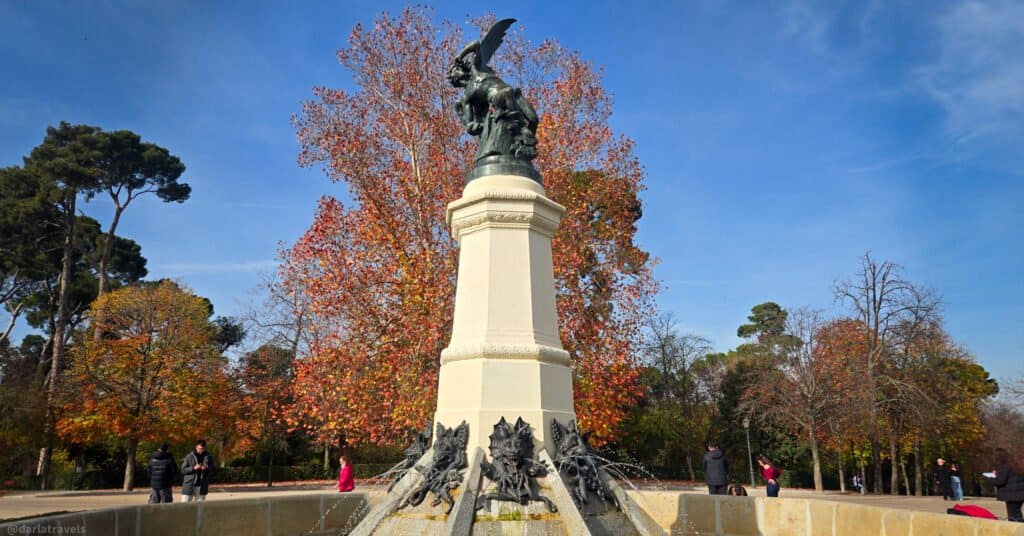
These are just a few features you might encounter on a walk in Retiro Park.
A Relaxing Walk in Madrid’s Retiro Park
You could spend hours in Retiro Park exploring the gates, statues, fountains, gardens, and more without a particular path in mind. Although you don’t need to follow any given route, AllTrails has one trail map within Retiro Park that is 2.2 miles long (3.5 km).
Click for Map
Self-Guided Audio Tour
Suppose you’d like a guided audio walking tour of Retiro Park with details and history. In that case, I highly recommend the VoiceMap app tour named El Retiro Park’s Rise, Ruin and Redemption: A Tour of the Former Royal Retreat (use the voucher code tamchn when purchasing this or any other tour on VoiceMap). A travel writer living in Madrid created this excellent 1.5-mile (2.4 km) tour.
VoiceMap uses GPS, even if you’re offline, to direct you and play relevant audio as the tour progresses. I like VoiceMap for many reasons. Most tours are very reasonably priced, and I can start a tour at any time. I can also walk at my own pace during the tour and take breaks whenever I feel like it.
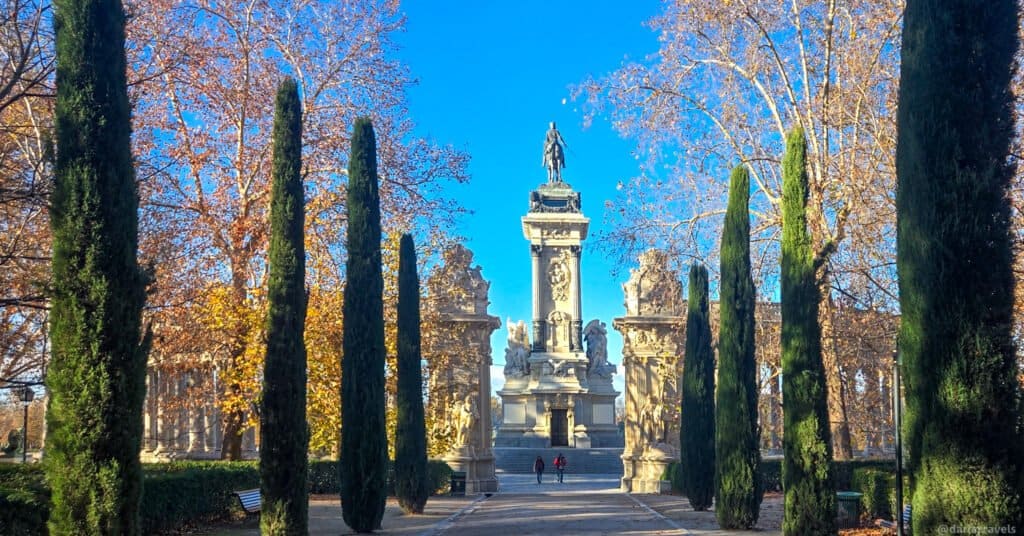
Practical Information for Retiro Park
- Admission: Retiro Park is a FREE city park. There is no entry fee.
- Location: The address for Retiro Park is Plaza de la Independencia, 7, 28014 Madrid, Spain (near the Prado Museum).
- Hours: The park has extended hours: 6 a.m. to 12 midnight from April to September and 6 a.m. to 10 p.m. from October to March. (It is subject to closures in inclement weather.)
- Getting There: Madrid’s public transportation system makes Retiro Park accessible via many bus routes that stop next to the park. If you take the metro, you can reach Retiro Park from one of these stops: Atocha (Line 1), Estación del Arte (Line 1), Ibiza (Line 9), Príncipe de Vergara (Line 2, Line 9), or Retiro (Line 2).
- Food and Drink: The park has several kiosks and cafes.
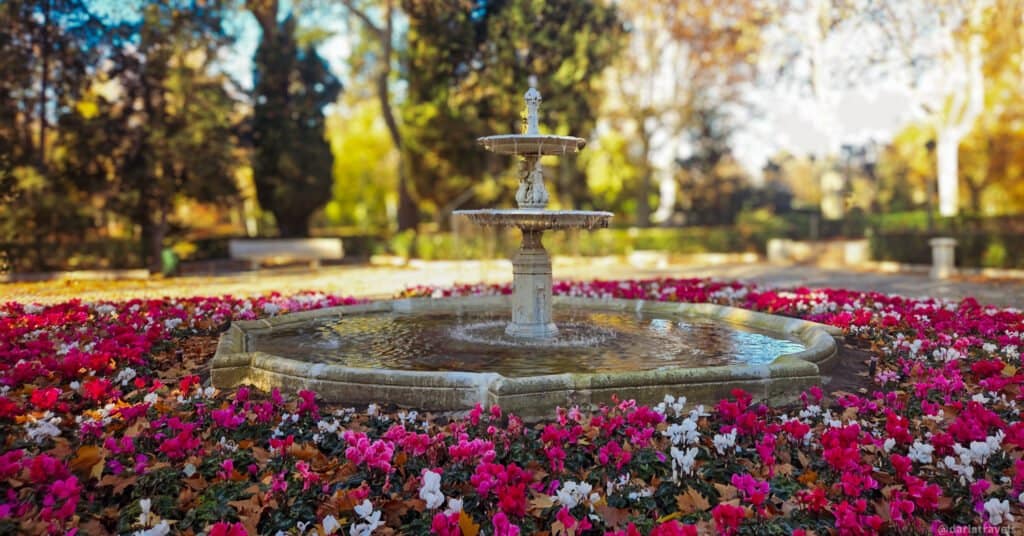
The next walking location is adjacent to El Retiro Park, and it’s another green space with a royal past.
Walk #2: Walking in the Real Jardín Botánico de Madrid (Royal Botanical Garden of Madrid)
The Royal Botanical Garden of Madrid is not just a garden; it’s a center for botanical research and education, housing over 5,000 plant species from around the world. Madrid has had a royal botanical garden since 1755. It’s been at its current location on the Paseo del Prado (discussed below) since 1781. A ramble into this green oasis of 20 acres (8 ha) will expose you to over 5,000 plant species from around the world.
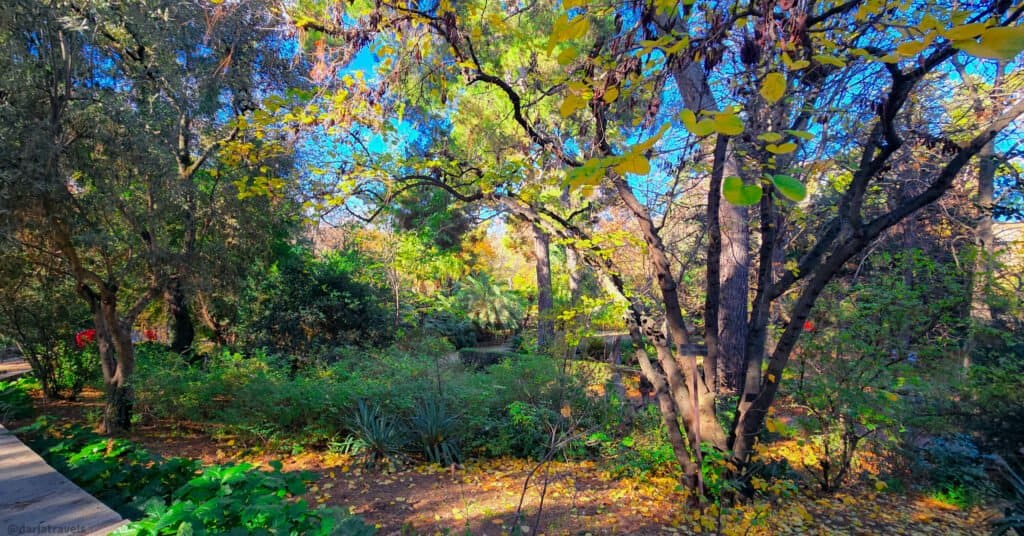
Things to See on a Relaxing Walk of the Royal Botanical Garden of Madrid
The Garden’s outdoor sections are ideal for walking. The Terrace of the Grids is laid out in a grid pattern, and each individual square has a fountain at its center. Here, you’ll find squares with ornamental trees, aromatic and medicinal plants, a rose garden, and an orchard.
The Terrace of the Schools is also grid-patterned. Plants in this section are arranged by classification, with evolutionary-close species grouped together.


In contrast, the Flower Outline Terrace adopts a romantic style. Curving paths pass through a variety of trees and bushes within a wrought-iron trellis.
The newest addition to the outdoor spaces (since 2005) is the Bonsai Terrace, which features bonsai specimens. This area overlooks the other three terraces.
You can also walk through two greenhouses to see different kinds of plants unsuitable for Madrid’s climate. The walking inside these buildings may be slower, as the paths are narrow, but the additional variety of plants makes the visit worthwhile. The Exhibition Greenhouse displays plants from tropical, subtropical, and desert environments. The Graells’ or Palms’ greenhouse displays ferns, mosses, and aquatic plants.
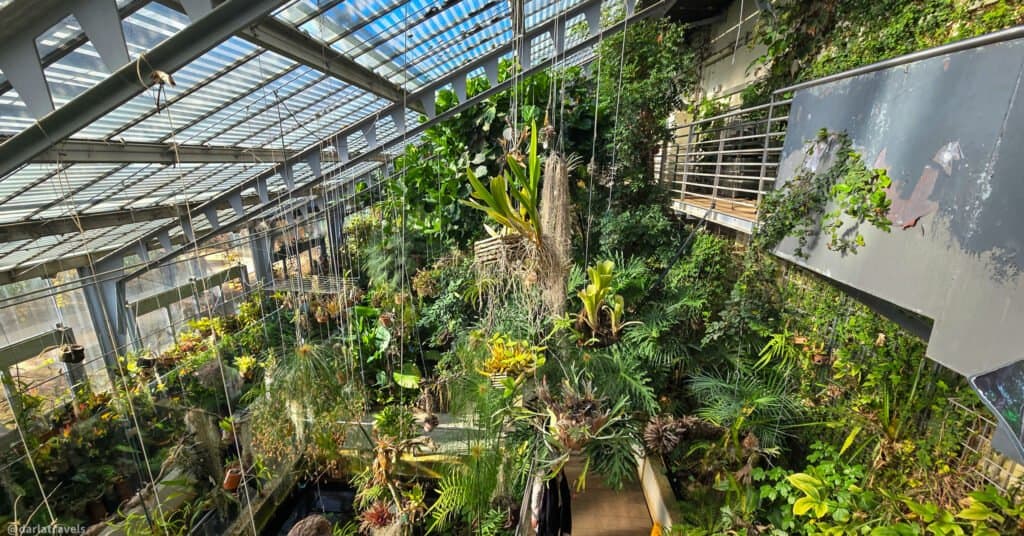
Recommended Walking Routes in the Royal Botanical Garden of Madrid
Your path in the Royal Botanical Garden may depend on your mood. You might stick to an area with plants of particular interest to you. Or maybe you’re intrigued by the garden designs or fountains. I wanted to see everything, so I maximized the walking distance by methodically traversing each row from end to end.
If you’re in a learning mood or just want a more directed visit, the Royal Botanical Garden’s official website provides two routes that highlight different types of plants.
The Unique Trees Route
The Unique Trees route takes the visitor through the gardens to see 15 of the oldest and tallest trees, as well as trees of special historical interest.
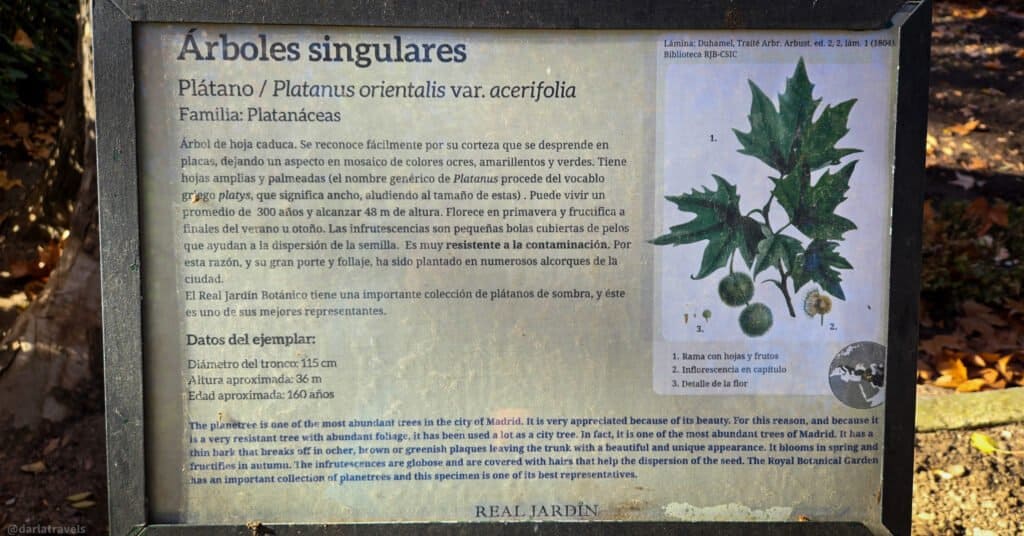
The Andalusian Route
Use the Royal Botanic Garden to explore the heritage of Al-Andalus on the Andalusian Route. The Muslim kingdom ruled Spain from the 8th to the 15th centuries. The itinerary includes 15 plants, many notable for their medical or gastronomical contributions.
Practical information for Madrid’s Royal Botanical Garden
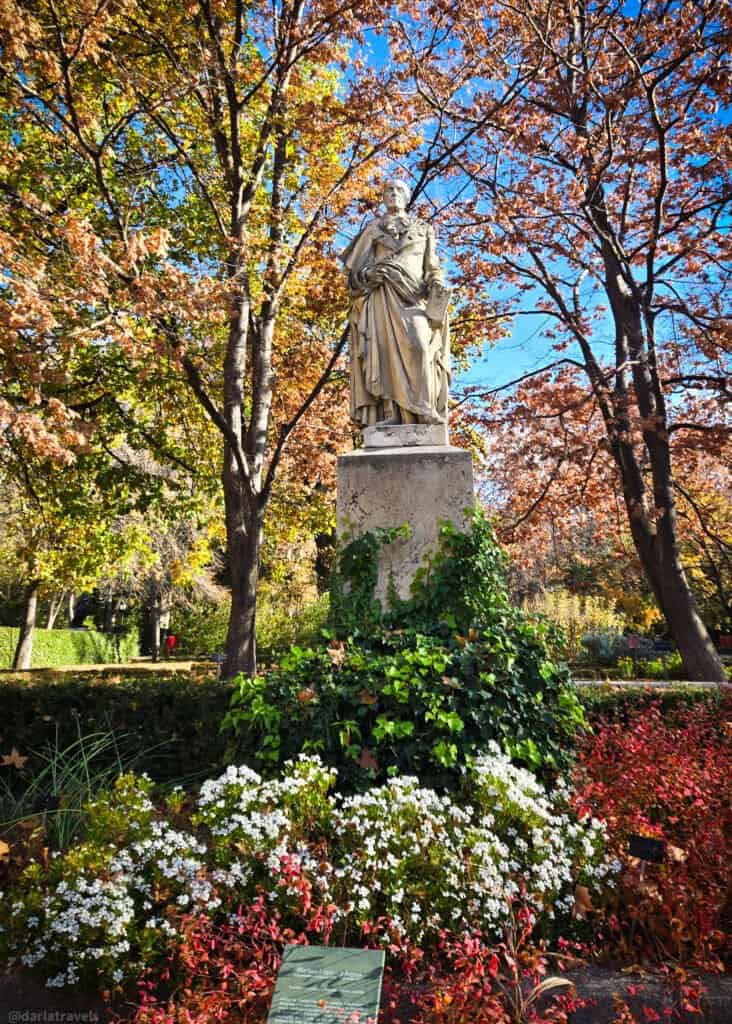
- Admission: Admission is €4 for adults, and tickets can be purchased at the entrance or online.
- Location: Plaza de Murillo, 2, 28014 Madrid, Spain (next to the Prado Museum), close to Retiro Park
- Hours: The Garden is open daily, but hours vary based on the time of the year:
- 10:00 a.m. to 9:00 PM (May to August)
- 10:00 a.m. to 8:00 PM (April and September)
- 10:00 a.m. to 6:00 PM (November to February).
- Food and Drink: The Villanueva Pavilion (named after the architect who designed it) includes a café-bar, and it’s a lovely spot to take a break and enjoy some refreshment after you walk the Garden. It also has a gift shop and may include temporary art exhibitions.
- Getting There: Many of Madrid’s bus routes stop near the Royal Botanical Garden. The closest metro stops are Atocha (Line 1), Banco de España (Line 2), and Estación del Arte (Line 1).
Walk #3: Strolling the Parque Madrid Río (Madrid River Park) from Matadero to Puente de Toledo
Now it’s time to move to Madrid’s riverfront. Parque Madrid Río is a dynamic urban park that stretches over 6.2 miles (10 km) along the banks of the Manzanares River. This expansive green space (1,730 acres, 700 ha) was formed as part of a large-scale urban renewal project from 2003 to 2011. If you are looking for a relaxing walk in Madrid’s parks, look no further!
During this transformation, planners relocated the M-30 Ring Road underground, allowing the enhancement of the river with numerous bridges, pedestrian paths, and green spaces. With city neighborhoods no longer separated by a highway, the river and the River Park can contribute to the city’s recreational and cultural life. The effect was so profound that the park has received numerous architecture and landscape awards.
In addition to scenic pathways for walking and cycling, the Madrid River Park includes playgrounds, sports facilities, and several cultural landmarks. Start your walk at one such landmark: the Matadero Madrid Arts Center.
Things to See Walking Madrid’s River Park starting at the Matadero
The Matadero complex is an easy-to-get-to starting point for a walk in Madrid River Park. It is culturally significant and covers about 1.7 miles (2.7 km), ending at the Puente de Toledo (Toledo Bridge).
The Antiguo Depósito de Agua (water tank) announcing the Matadero complex is an 82-foot (25 m) tall visual landmark for this cultural center that hosts art exhibitions, theatre productions, festivals, live music, dance companies, cinematic projects, and educational programs and activities.
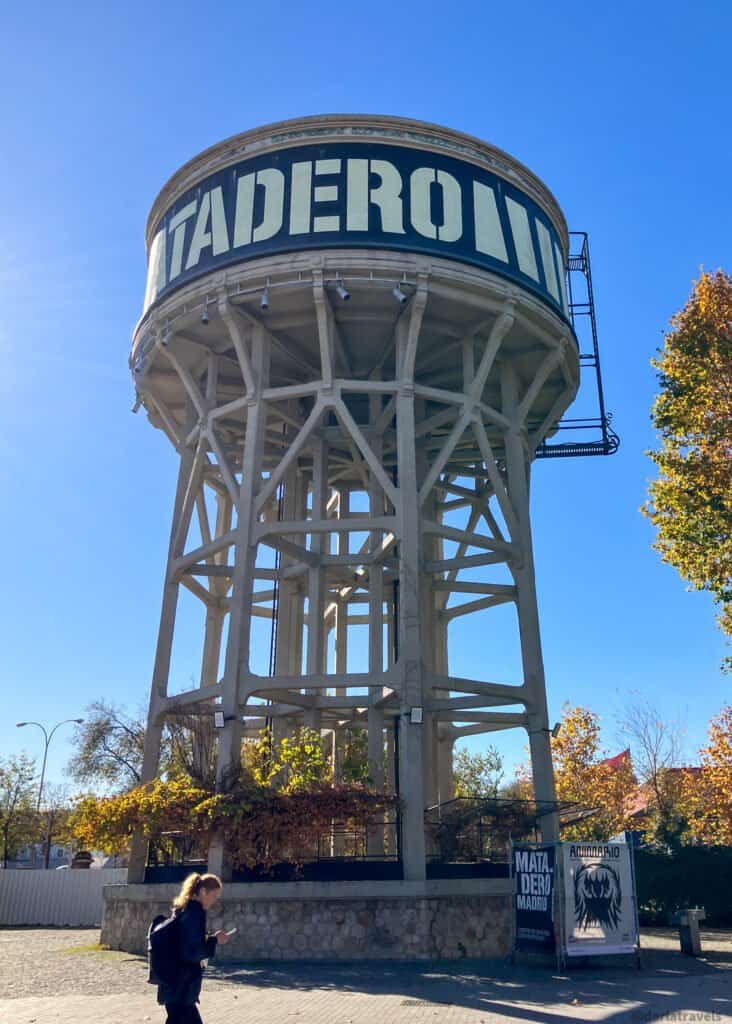
The Matadero was originally a slaughterhouse and meat market, processing cattle, pigs, sheep, and poultry for distribution to Madrid’s markets. Hence the need for the water tank. The Matadero is significant for its historical purpose and Neomudejar-style buildings with red brick walls, arched windows, tiled roofs, and ceramic decoration.
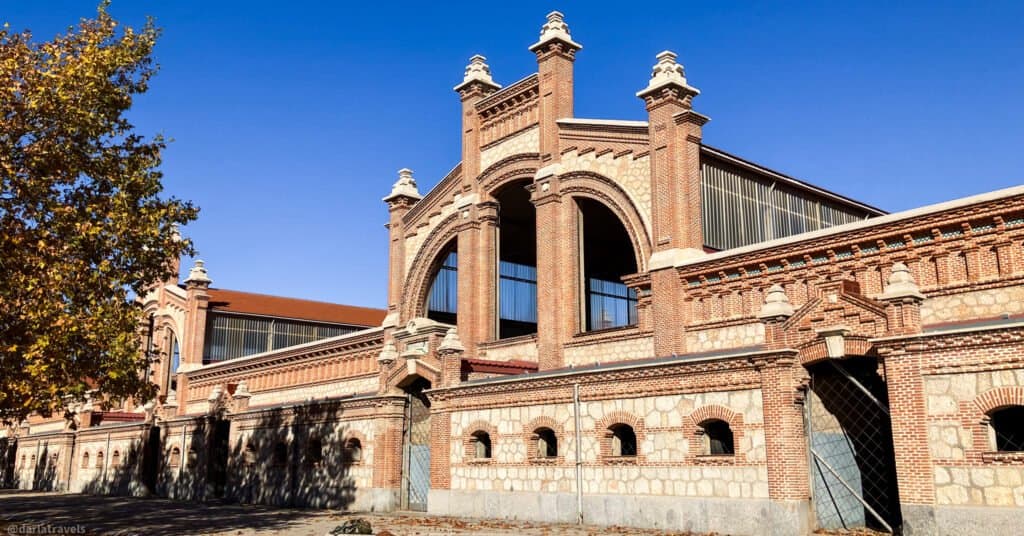
From the Matadero complex, walking toward the river and finding the paved path to follow to the right is easy. You’ll soon see the Puente Cáscara del Invernadero (Invernadero Shell Bridge). This modern pedestrian and bicycle bridge has a reinforced concrete arch and steel deck. Look for the shiny new Plaza Rio 2 shopping center on the other side of the river, with a viewing platform on the top floor.
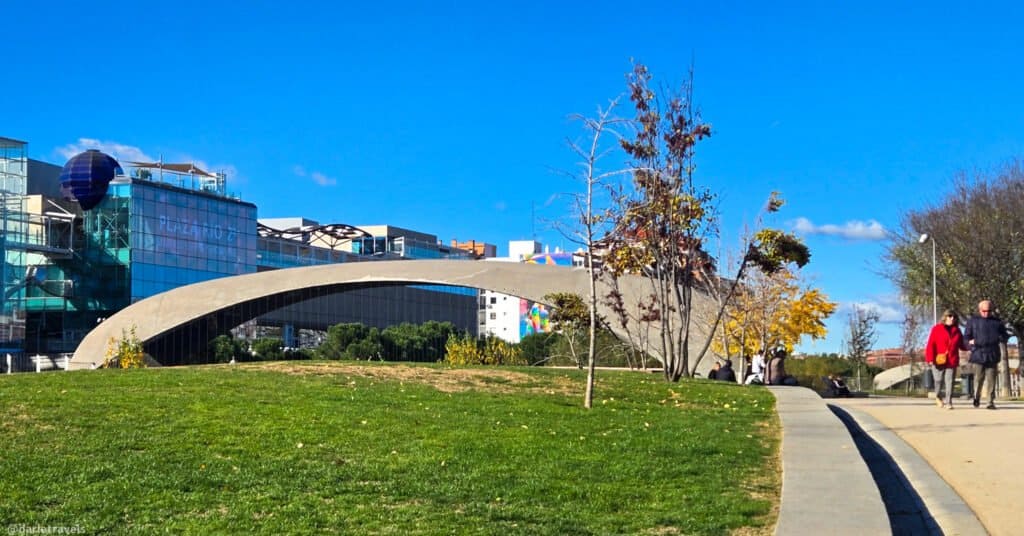
Walking, you may notice that the Manzanares River is relatively modest as rivers go, with neither an extensive nor rapid water flow. Instead, the gentle currents of Manzanares give off a serene vibe for your river stroll.
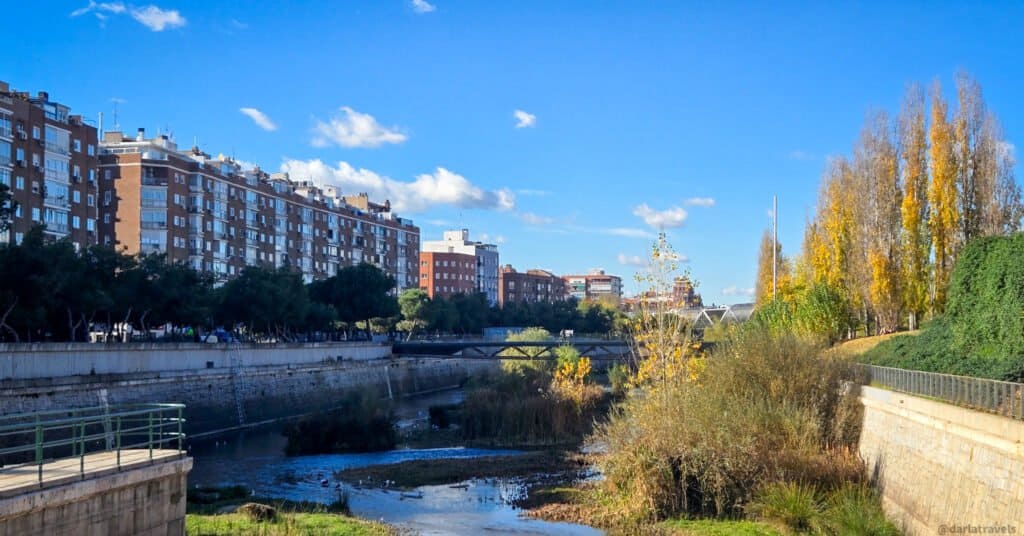
As you walk, you’ll see many outdoor activity areas, such as a skateboard park, skating rink, soccer pitch, basketball court, pétanque (a type of French bowling) court, tennis courts, and a climbing wall.
Among the trees, be sure to look for the Obelisco de la Castellana (Obelisk of the Castilian Fountain, Obelisk of Arganzuela), a monument built in 1833 to celebrate the birth of Queen Isabella II. It was once a fountain and has been in many locations around the city. Sitting in the Madrid Rio Park, notice the two coats of arms on this granite structure: one represents the Royal House of Castile and Leon, and the other is the coat of arms of Madrid. Look carefully at the sphinx statues that appear to guard the monument–they used to be elements of the fountain with water pipes coming from their mouths.
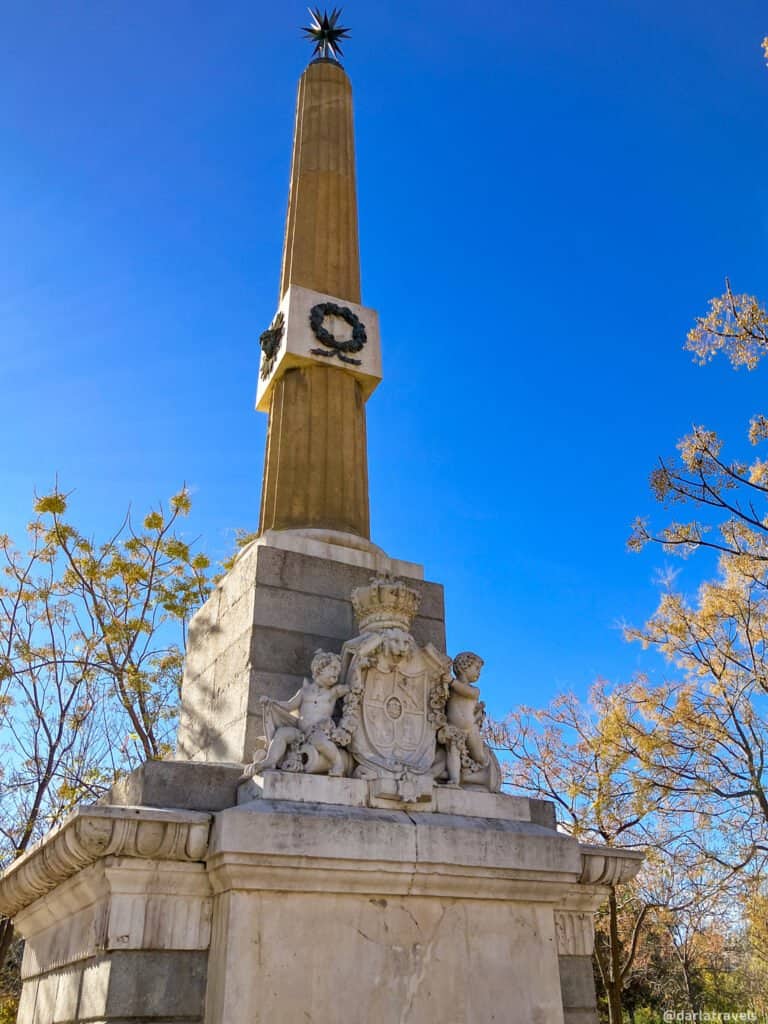
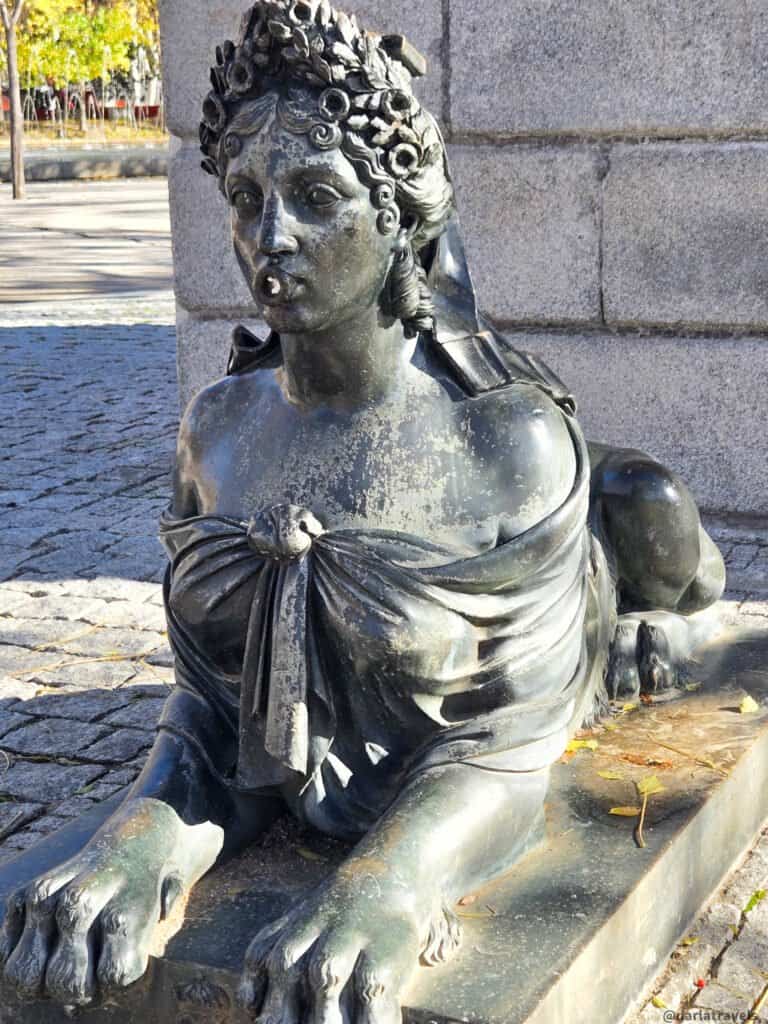
There are 17 play areas for children within the Madrid River Park. One of these is eight large Toboggans (metal slides) built into a tall rock that beckon the young, and perhaps the young at heart, to engage in some play.
Near the toboggans, the Playa de Madrid (Madrid beach) is an area that, while not a real beach, features vertical jets of water meant for cooling off in the summer. It’s the only urban fountain in Madrid where bathing is allowed.
At this point, you won’t be able to miss the marvelous Puente de Arganzuela (Arganzuela Bridge). This architectural icon, with a distinctive spiral tunnel design, opened in 2011. Go ahead and cross this pedestrian bridge, staying out of the bicycle lane while admiring the modern double corkscrew around you.
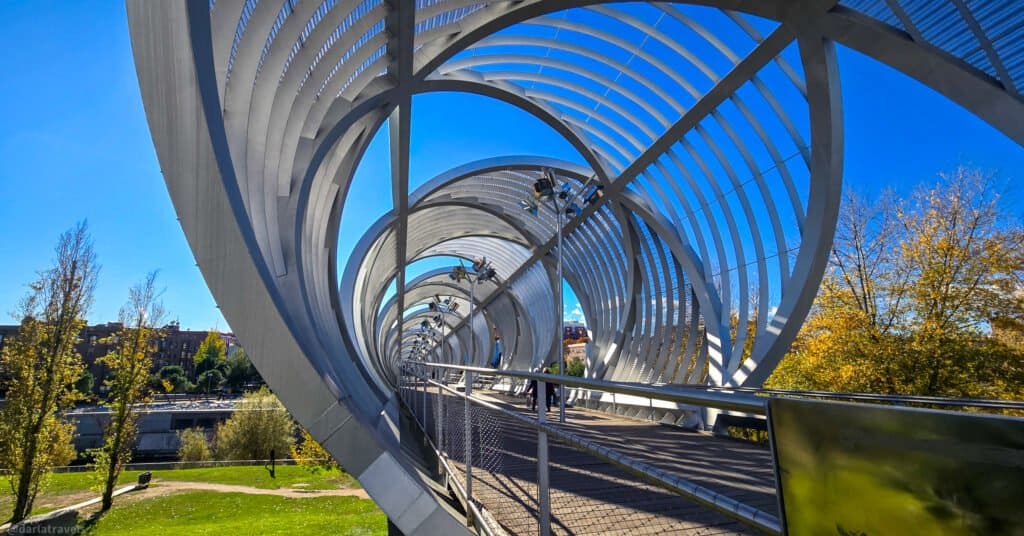
From the other side of the river, continue walking toward another pedestrian bridge, the historic Puente de Toledo (Toledo Bridge), a baroque-style bridge built in the 1700s. Constructed with hewn granite stones, its old-world charm is a reminder of Madrid’s long history and architectural heritage. At the central arch of the bridge, small enclosures on either side contain sculptures of Madrid’s patron saint, San Isidro, and his wife, also a saint, Santa María de la Cabeza.
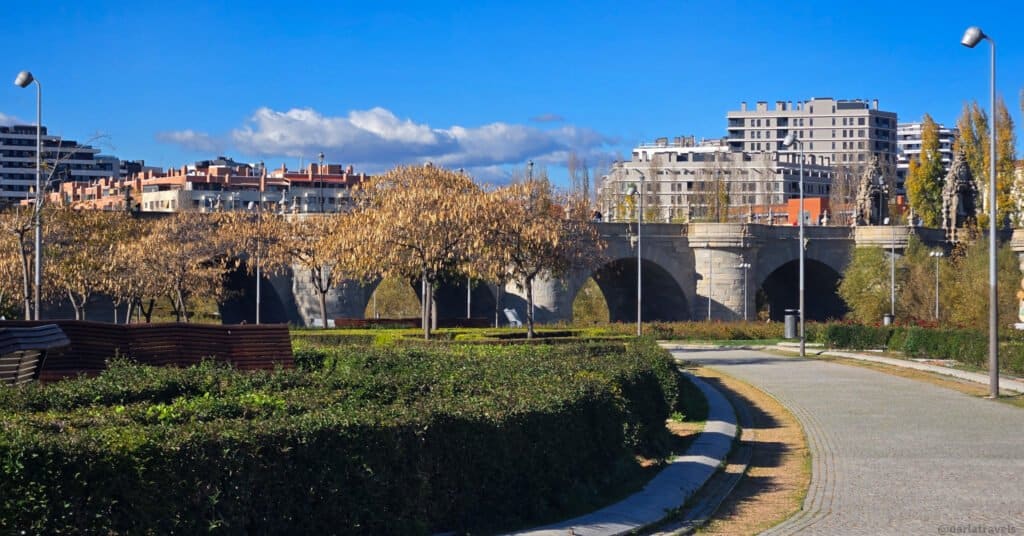
Historical Context and Additional Details for this Walk
I took this walk via the VoiceMap Tour Madrid Walking Tour: Manzanares River’s Story from Prehistory to Popular Park (use the voucher code tamchn when purchasing this or any other tour on VoiceMap). The tour developer is a former museum curator with a keen interest in the history of Madrid. She provides historical information on the role of the Manzanares River in Spain’s capital city. From wooly mammoths to the Spanish Civil War to the present day, this audio tour is chock full of engaging information on the history and features of the Madrid River Park.
Remember, VoiceMap uses GPS to deliver audio at the appropriate location as you walk. You can start and complete any audio tour at any time and at your own pace.
Practical Information for Madrid Rio Walk from Matadero to the Toledo Bridge.
- Admission: FREE
- Location:
- Start: Matadero Water Tower
- Finish: Toledo Bridge
- Hours: The Madrid River Park path is open 24 hours a day.
- Getting There and Back:
- The closest metro station to the Matadero Water Tower is Legazpi (Line 6), and multiple bus lines have stops at the Legazpi roundabout adjacent to the Matadero.
- The closest metro station to the Toledo Bridge is Marqués de Vadillo (Line 6). Get to it by backtracking on the bridge. Going forward, you’ll see bus stops at the Las Pirámides roundabout a short distance away. Multiple buses stop here that can take you to your next destination.
- Food and Drink: The park has several kiosks and cafes. But after your walk, why not take a bus to the Plaza Mayor area to eat at the Mercado de San Miguel? At this venerated food hall, you can indulge in tapas from multiple vendors and wash them down with sangria or a reasonably priced Spanish wine.
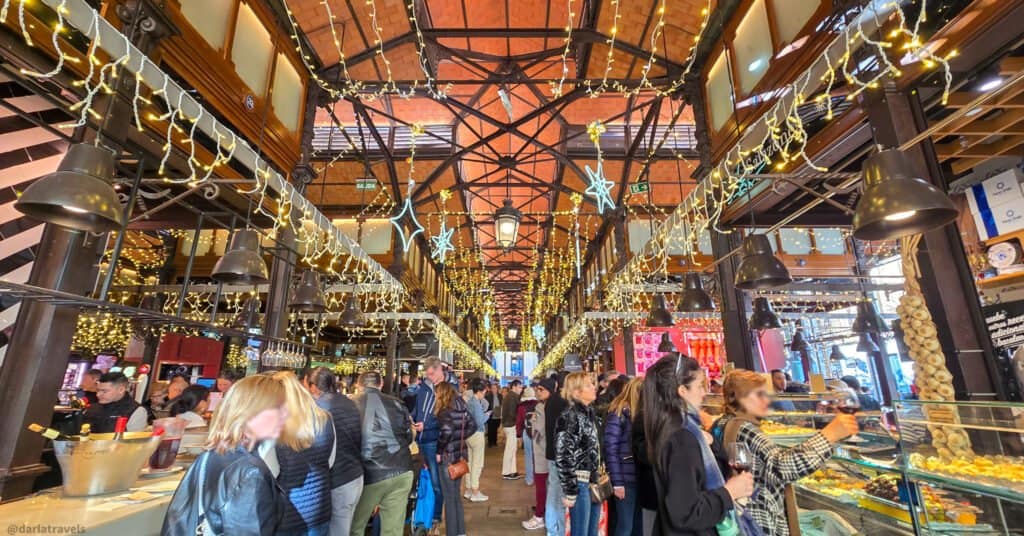
Walk #4: Exploring the Parque Madrid Río (Madrid River Park) from the Puente Segovia (Segovia Bridge) to Puente del Rey (Bridge of the King).
I liked the Madrid River Park so much that I decided to walk another section, this time from the Segovia Bridge to the Bridge of the King. This section is approximately 1.3 miles (2 km) long.
The Puente de Segovia, or Segovia Bridge, is a historic bridge built between 1582 and 1584. It was demolished in November 1936 during the Spanish Civil War. After the Civil War, the bridge was reconstructed with modifications to accommodate increased traffic demands, and it continues to be used for vehicular traffic today.
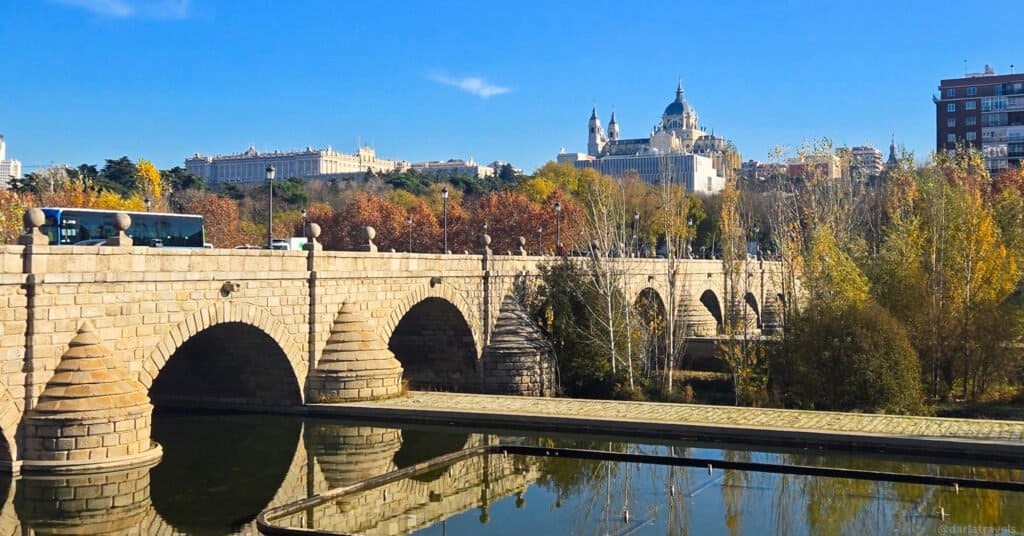
If you’re on the right bank of the river, cross the bridge and keep walking to get a good look at the smallish Chapel of the Virgen del Puerto (Virgin of the Harbor). This hermitage, built between 1716 and 1718, was completely reconstructed in 1945. It’s the historic site of the city’s Melonara Festival, held yearly in September, coinciding with the end of the summer. The festivities include concerts, food, cultural exhibits, and a mass and procession in honor of the Virgen del Puerto.
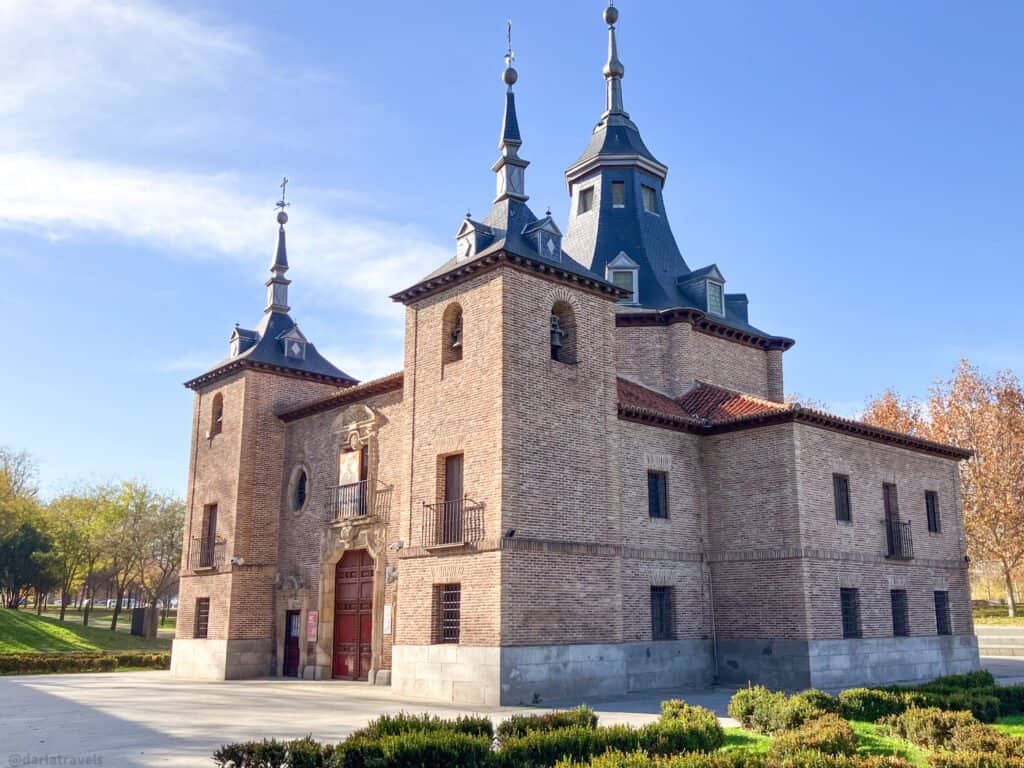
Walking across the green space and back to the river path, look for a bridge over the river and walk to the structure in the middle. You’re standing on Presa No. 5, a small dam. It’s one of 9 dams built on the river in the early 1900s in an attempt to turn the river into more of a canal. When metal walls at these dams restricted water flow, the river lost its original character. The result was the loss of wildlife habitats and disruption of the river ecology. The development of the Madrid River Park restored the river, allowing the return of local wildlife and increasing biodiversity.
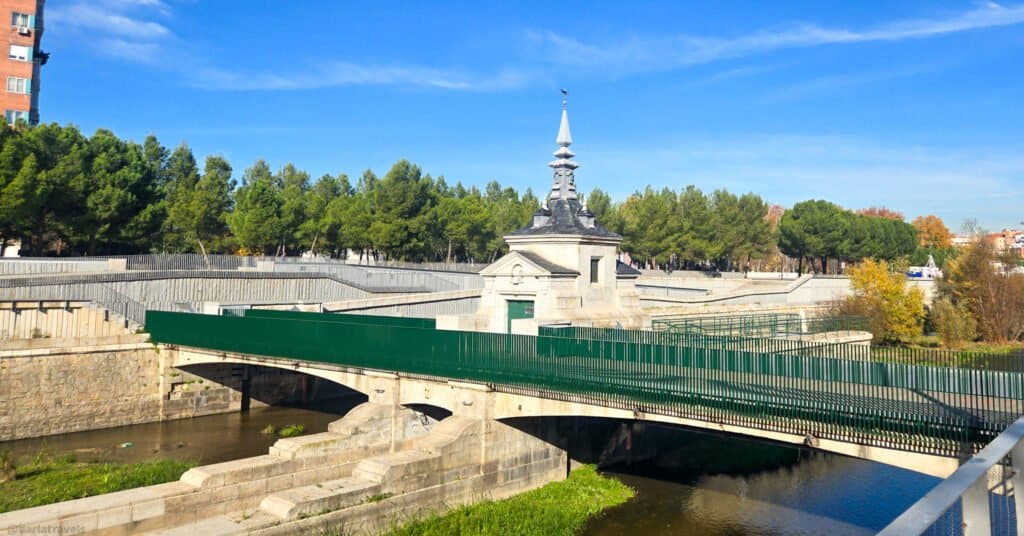
After crossing the presa, walk along the river to find the Madrid Río Sign, where you can take the perfect selfie.
At this point, you’ll want to depart from the river and stroll in the Huerta de la Partida (orchard). This lush green space was once an orchard and gardens for the Vargas family’s 16th-century country home. The orchard area was improved as part of the revitalization of the Manzanares River and the construction of the Madrid River Park. This lush green space now contains walking paths among over 800 fruit and nut trees. Don’t miss the Mirador de la Huerta de Partida, the highest point in the orchard. This viewpoint has excellent views of the Royal Palace, the Almudena Cathedral, and Madrid’s first skyscrapers.
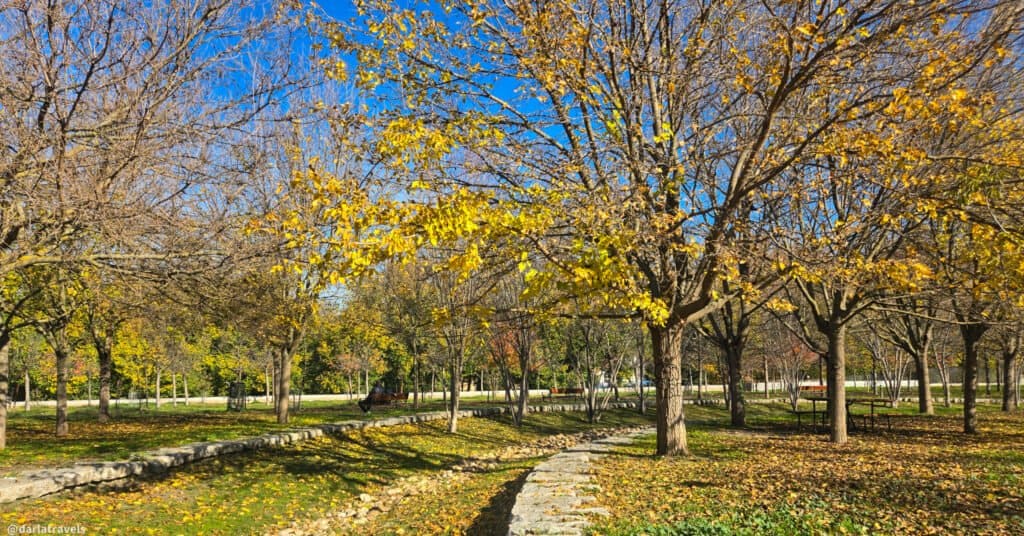
Leaving the orchard, follow tree-lined Paseo del Embarcadero back toward the river to arrive at the Fuente de la Buena Suerte, or Fountain of Good Luck. Notice the shell designs in this fountain. It has been installed in several places in Madrid since 1858 but was moved to this location in 1934. The fountain was named during its residency in Madrid’s Puerta del Sol from about 1860 to 1895. The residents developed a tradition of splashing water from the fountain on their faces at midnight on the summer solstice, believing the action would bring them a year of good luck.
This location is the entrance to the Casa de Campo, Madrid’s largest park and former royal hunting ground. Walks in Casa de Campo are described below. At one time, a gate near the tree line behind the fountain ensured only the royal family and their guests could enter. Today, six pillars mark the park entrance. These columns from the former gate are arranged in a semicircle on the other side of the fountain with the name Puerta del Río or the Puerta del Rey.
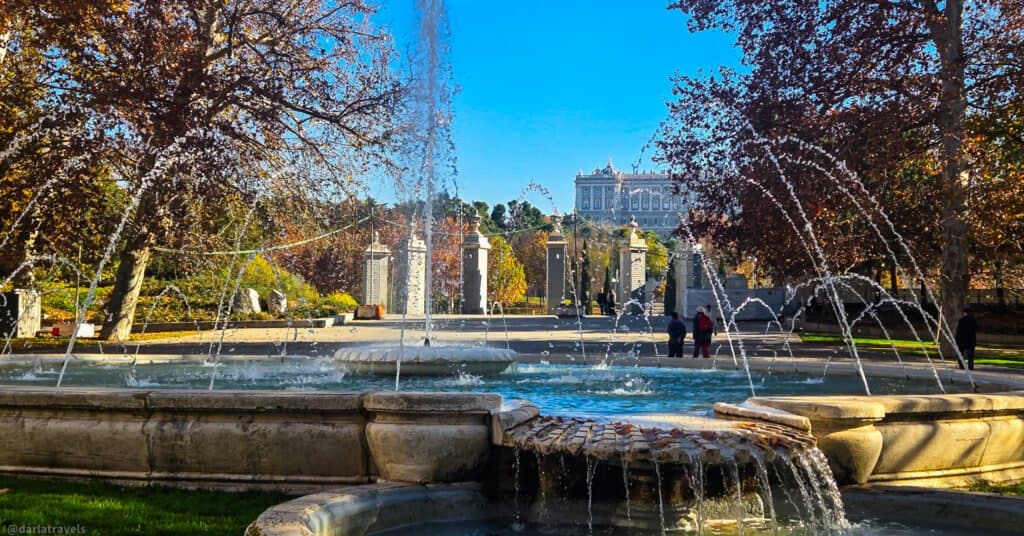
This walk ends at the Puente del Rey, or King’s Bridge, which crosses the river here. Initially built in 1816, the bridge allowed royalty to get to Casa de Campo. Widened in 1931, once the Casa de Campo opened to the public, it’s now a pedestrian-only crossing.
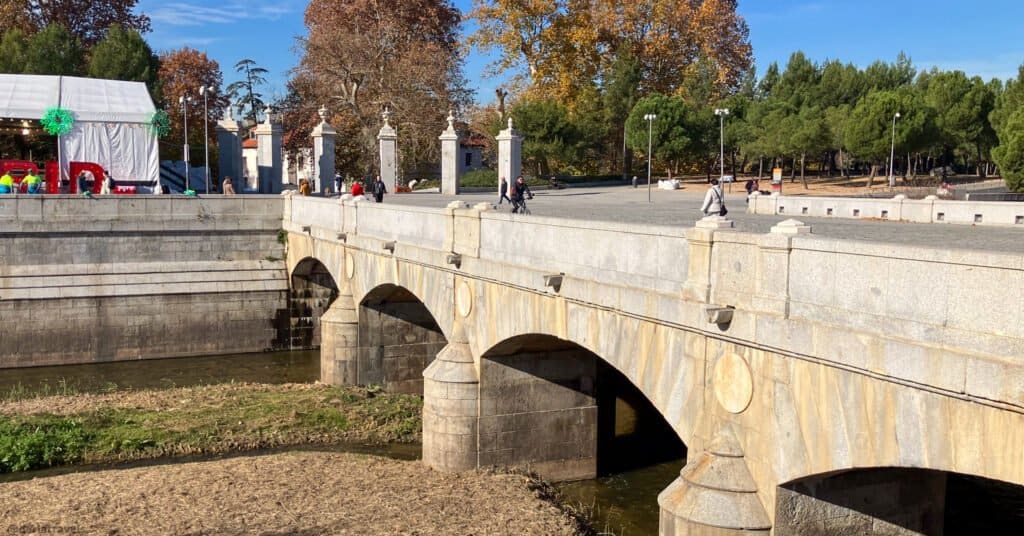
A mural in the plaza explains and shows changes to the bridge area and park entrance from 1909 to 2009.
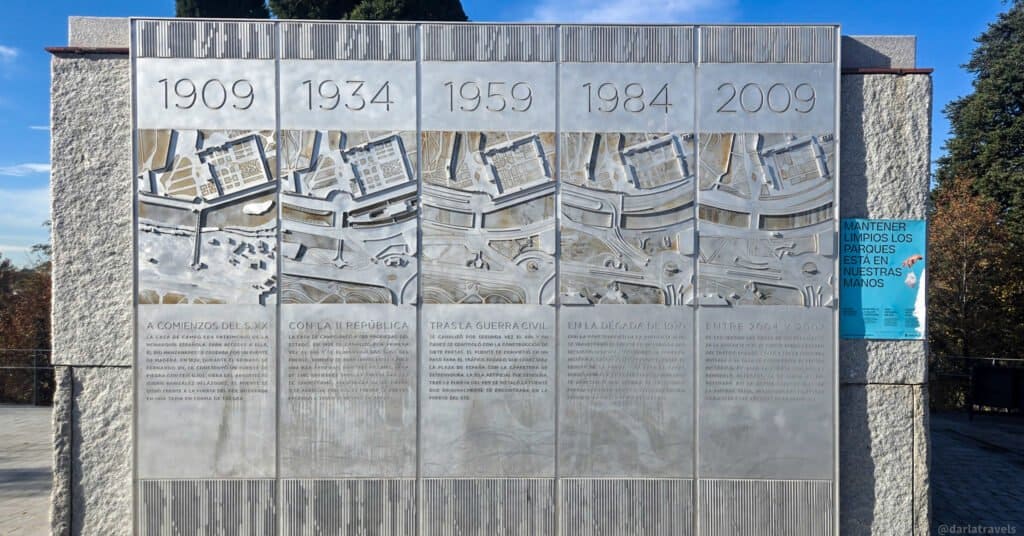
Historical Context and Additional Details for this Walk
I took this walk via the VoiceMap Tour Madrid’s Golden Age: 500 Years of History along the Manzaneres River (use the voucher code tamchn when purchasing this or any other tour on VoiceMap). The tour narrator is the same museum curator who led the previous tour in the Madrid River Park. She continues to provide a wide range of historical information on this tour.
Practical Information for the Madrid River Park Walk from the Segovia Bridge to the Bridge of the King
- Admission: FREE
- Location:
- Start: Puente de Segovia (Segovia Bridge)
- Finish: Puente del Rey (Bridge of the King)
- Hours: The Madrid River Park walking path is open 24 hours a day.
- Getting There and Back:
- The closest metro stop to the Segovia Bridge is Puerta del Ángel (Line 6).
- From the Bridge of the King, the closest metro stop is Príncipe Pío (Lines 6, 10, and R)
- Madrid’s bus system has several stops near these landmarks.
- Food and Drink: For more views of Madrid from this side of the city, try the Cafe del Rio near the Madrid Rio sign. This eatery has an outdoor terrace and a scenic lookout point on the upper floor.
Now that we’ve arrived at the Casa de Campo Park entrance, you’re ready for the next walk in this park.
Walk #5. An Easy Hike in Casa de Campo Park
Casa de Campo Park is Madrid’s largest city park by a long shot, and it’s ideally suited to long walks on the park’s natural surface paths. At 4,257 acres (1723 ha), it’s about five times larger than New York City’s Central Park. Not only is it the largest urban park in Madrid, but it’s also the largest urban park in the whole of Spain! This just might be the best place to take a relaxing walk in Madrid!
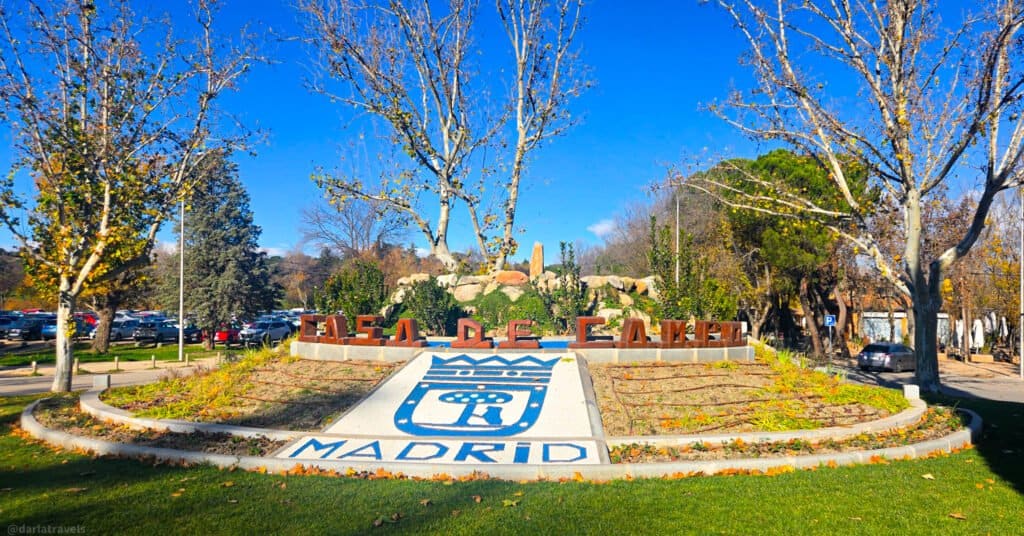
Overview of Casa de Campo
Located west of central Madrid, Casa de Campo dates back to the mid-16th century. Originally a royal hunting estate established by King Philip II, it was exclusively used by the Spanish royal family for centuries. In 1931, the park opened to the public during the proclamation of the Second Spanish Republic. Today, Casa de Campo is a beloved public park that offers hiking and biking paths, an amusement park, a public pool, a boating lake, a cable car, and a zoo.
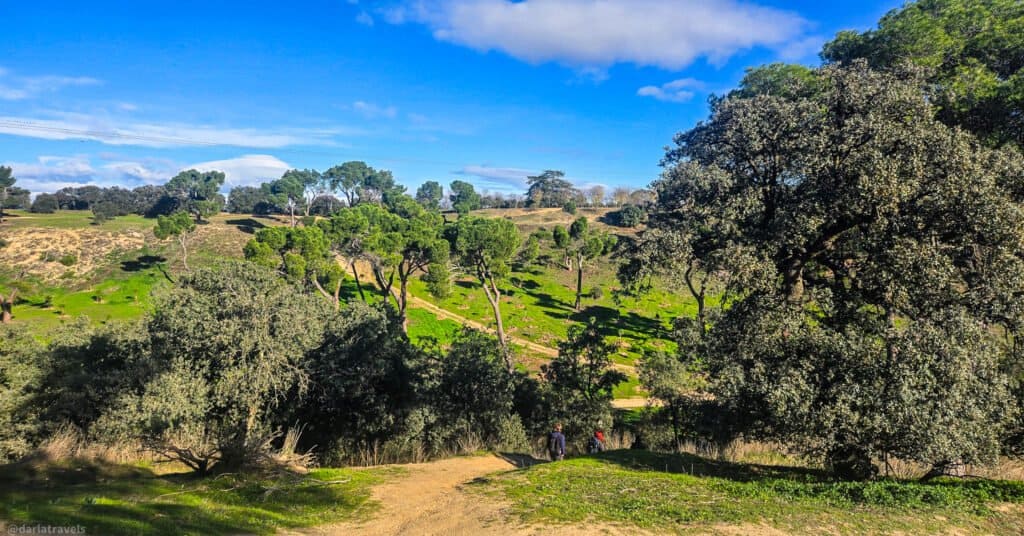
Recommended Walking Route in Madrid’s Casa de Campo
This large park has many walking trails, most on natural surfaces, although some paved roads exist. In some places, multiple trails seem parallel but cross over one another. Therefore, bringing a map and/or GPS tracking device is essential to keep track of where you are when traversing this enormous park.
Loop from the Lake
On my visit to Casa de Campo, I walked a 5.5-mile (8.9 km) loop route with 323 feet (98.5 m) of elevation gain that I found on AllTrails. The loop started and ended near the park’s lake (Lago). (Note that this is a different starting location than the King’s Bridge area in the previous walk in Madrid Rio Park.)
This loop passes a station for Madrid’s cable car, run by the Teleférico de Madrid. Due to structural damage, the cable car stopped operating in 2022 but will reopen in 2026 with new, more spacious cabins. The cable car station is at a high point, providing sweeping views of the park and the city of Madrid.
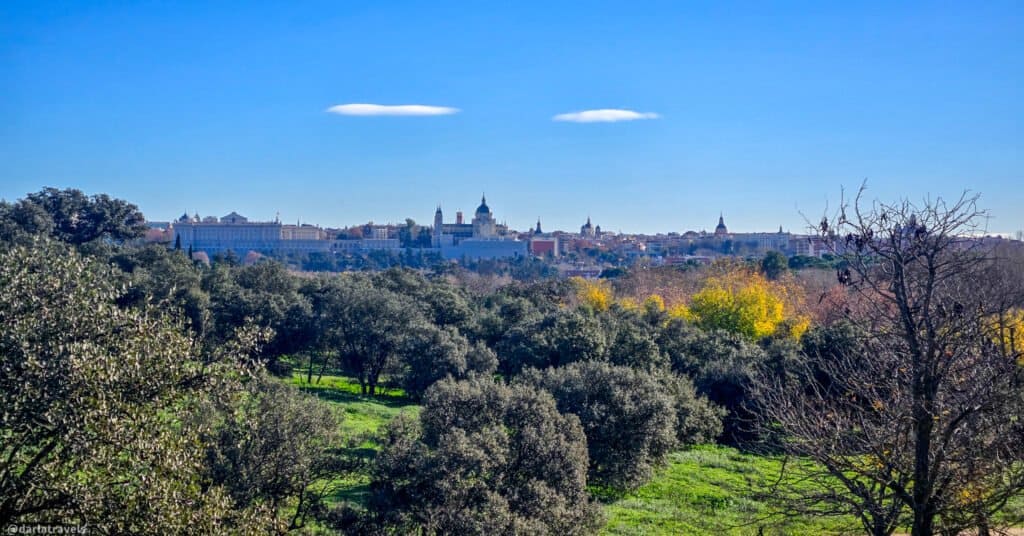
Another fun stop on this hike was the Fuente del Pajarito (Little Bird Fountain). Madrid has many fountains with potable water, and this one, standing in the middle of a green space with trees, looked pretty impressive. But I didn’t realize until later that it has an integral role in an annual ceremony celebrating the end of the carnival season called “Entierro de la Sardina,” or the “Burial of the Sardine.”
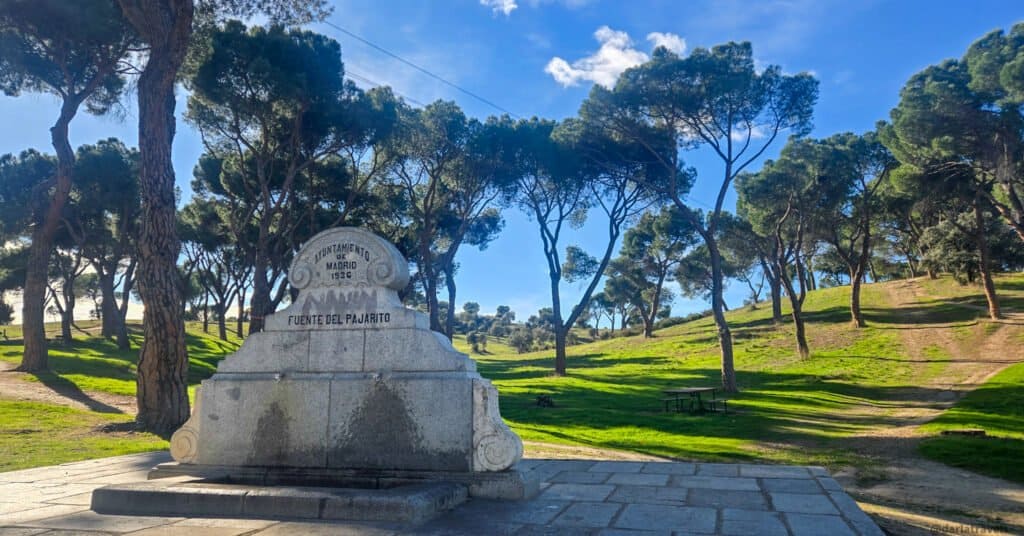
Accounts of the origin of this tradition vary, but for over 200 years, a mock funeral procession for a sardine (yes, the fish), complete with a sardine-sized coffin, has traveled through the streets of Madrid on Ash Wednesday. These days, the parade typically ends at or near the Fuente del Pajarito in Casa de Campo, where the symbolic fish is buried. A bonfire follows. Some say that this ritual symbolizes the spiritual cleansing that occurs during Lent.
After admiring the Little Bird Fountain, the hike concluded with a walk along the lakeshore, lined with numerous bars and restaurants.
I’ve included these points of interest and a few more on the following route map.
Don’t see the map or want to see the original? Click here
Other Walking Routes in Casa de Campo Park
My route was one of the shorter routes I found on AllTrails. Longer loops starting near the lake include:
- A 15 km loop with 229 m elevation gain.
- A 13.4 km loop with 178 m elevation gain.
- A 12.1 km loop with 163 m elevation gain
Check AllTrails for even more walks in Casa de Campo Park, some starting at different locations.
Practical Information for Casa de Campo Park
- Admission: FREE
- Location: The Official address for Casa de Campo is P. de la Prta del Ángel, 1, 28011
- Hours: Casa de Campo Park is open 24 hours a day.
- Getting There: Lago is the closest metro stop for this hike (Line 10). Other metro stops for park access are Batán (Line 10) and Casa de Campo (Line 5, Line 10).
- Food and Drink: Several bars and restaurants in the park have lakefront views.

For the last relaxing walk in Madrid’s parks, we’ll return to a special park within the city.
Walk # 6: A Sunday Stroll on the Paseo Del Prado in Madrid
The Paseo del Prado is close to Retiro Park and the Royal Botanical Garden featured above. Along with Retiro Park, it forms the UNESCO World Heritage Site named “Landscape of Light.”
What is the Paseo del Prado?
Madrid’s Paseo del Prado is a park with walking paths in the median area of a busy street of the same name. It may sound wild to look for a relaxing nature walk in the middle of traffic, but hear me out.

The Paseo del Prado dates from the 16th century. At that time, King Philip II wanted a space where all citizens, regardless of social class, could enjoy nature within the city’s boundaries. The result, the Paseo del Prado, was the first tree-lined urban promenade in a European capital.
Why walk the Paseo del Prado on Sunday?
Sunday is the best day to experience the Paseo del Prado as a standalone walk. This is because the street is closed to vehicular traffic on Sundays. With traffic barricades up, the noise level lowers, and the crowd can spread out on the street as needed.
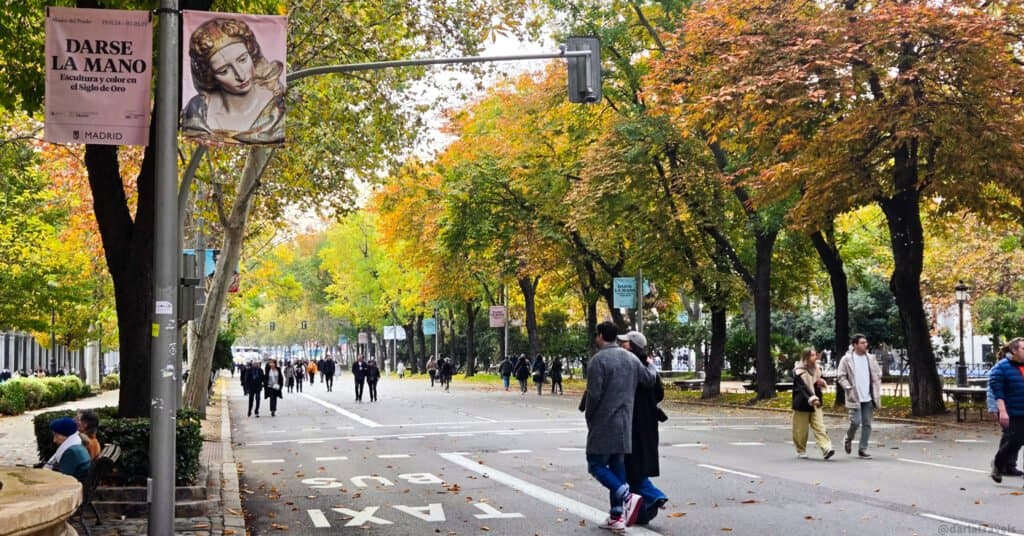
Things to see on the Paseo del Prado
Walking on the Paseo del Prado, you’ll see monuments, statues like the Monumento Eugenio d´Ors Rovira (Monument to Eugenio d´Ors Rovira), fountains, and playgrounds among the large shade trees. And there are plenty of benches among the grassy lawns if you’d like to sit and admire the surroundings.
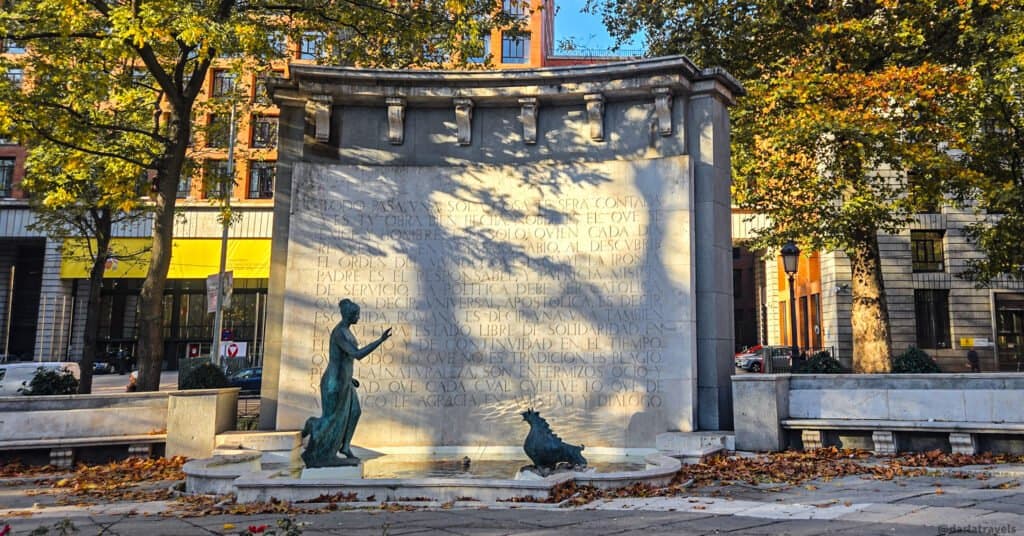
This urban park has some superb fountains. The Fuente de Neptuno and Fuente de Cibeles are the grandest but don’t overlook the charming Fuente de Apolo o de las Cuatro Estaciones or the Fuentes de las Cuatro Estaciones near the Prado Museum.
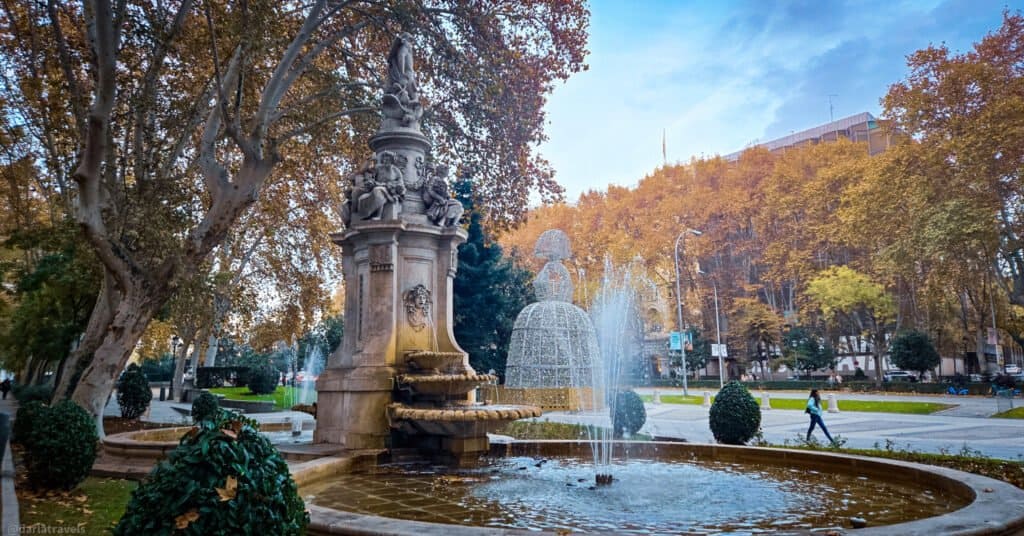
This park is also an easy route to the outstanding art museums just steps away, including El Museo Nacional del Prado, the Museo Thyssen-Bornemisza, and the Museo Nacional Centro de Arte Reina Sofía.
Other cultural institutions, such as the Royal Botanical Garden, highlighted above, are visible and easily accessible from the Paseo del Prado. For example, you can smile at the large dinosaur skeleton on display in front of the CaixaForum Madrid cultural center and admire the impressive Palacio de Cibeles (Cybele Palace), originally built as a post office.
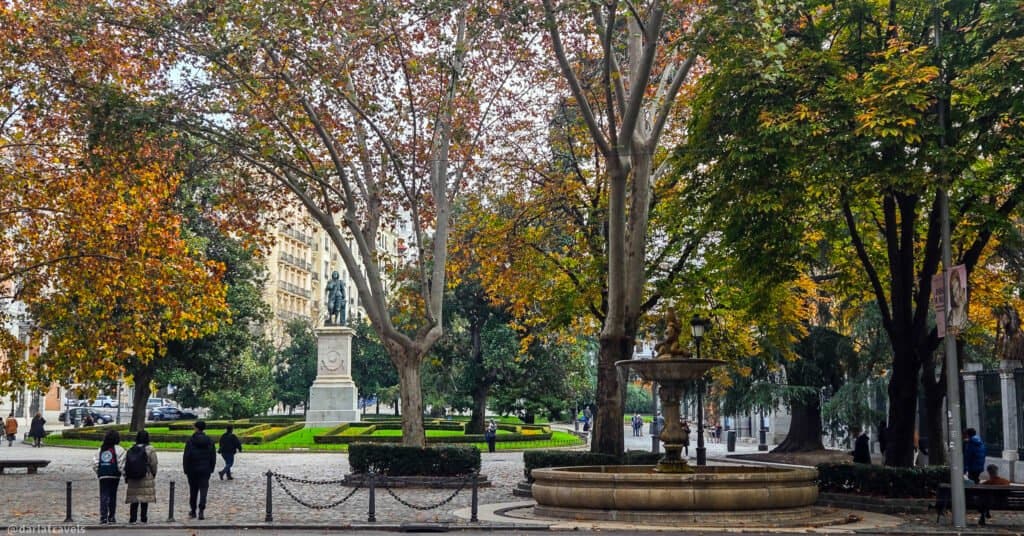
Practical Information for Walking the Paseo del Prado
- Admission: FREE
- Location: The Paseo del Prado runs north-south between the Plaza de Cibeles and the Plaza del Emperador Carlos V (also known as Plaza de Atocha). There is a break at the Neptune fountain. The address is Paseo del Prado 28014
- Hours: The Paseo del Prado is open 24 hours a day.
- Getting There: Numerous buses stop on or near the Paseo del Prado. The best metro stations for access are Banco de España (L2) and Estación del Arte (L1).
- Food and Drink: Numerous cafes, bars, and restaurants line the Paseo del Prado and nearby areas.
Where to Stay in Madrid
Madrid offers an almost overwhelming number of lodging options for tourists. Whether hotels, hostels, vacation rentals, or something else, Madrid has it. On my recent trip to Madrid, I stayed in the Atocha area, where it’s easy to access the Atocha train station, Retiro Park, the Royal Botanical Gardens, and the Paseo del Prado. This area also has a ton of bars and restaurants, and public transportation (metro and buses) is readily accessible.
Click here or use the map below to explore and book your lodging in Madrid.
Book now at Booking.com ♦ Book now at Expedia ♦ Book now at Hotels.com
A Relaxing Walk in Madrid’s Parks- Pin It for Later!
Here are a couple of images for your Pinterest boards:
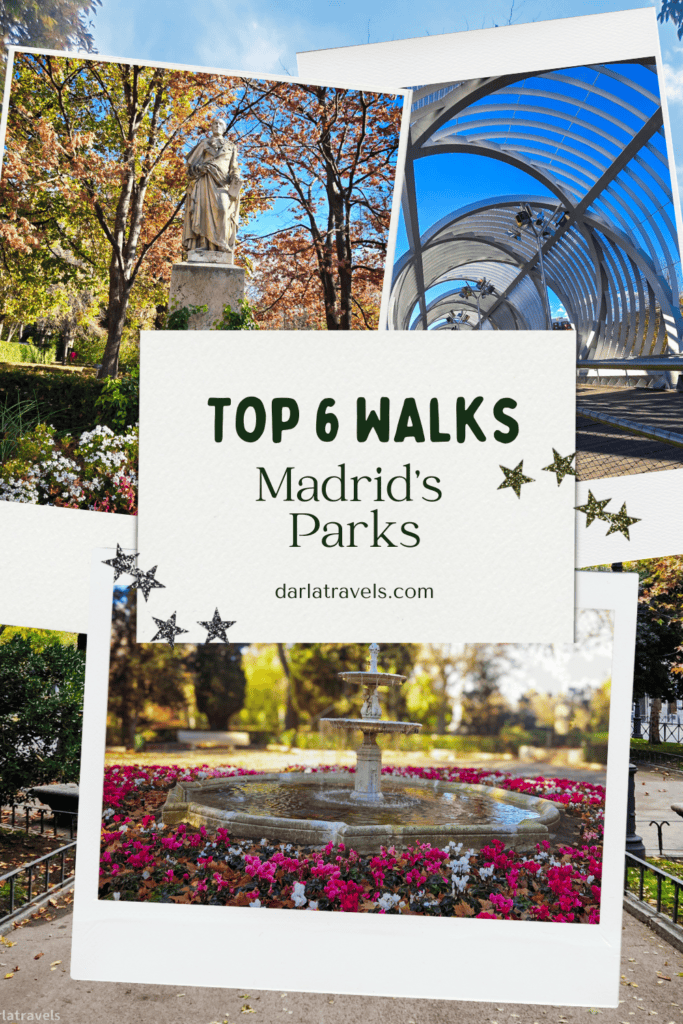
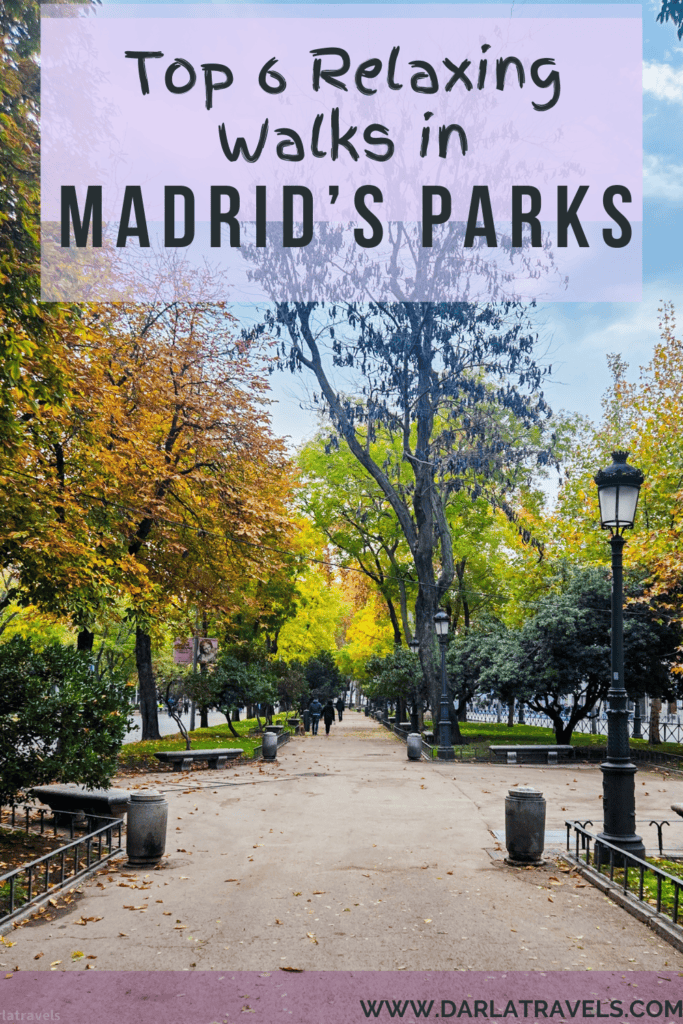
Summing up Relaxing Walks in Madrid’s Parks
Exploring the serene nature walks in Madrid offers a refreshing break from a city-based visit. Retiro Park, the Royal Botanical Garden, Madrid River Park, Casa de Campo, and the Paseo del Prado each provide distinctive experiences filled with natural beauty and tranquility. These green spaces invite you to relax and rejuvenate amidst stunning landscapes. You can enjoy these peaceful spots and connect with nature even in the heart of the city. Have you discovered the calming effect of a pleasant walk in one of Madrid’s beautiful parks?
I love all the fountains throughout town. Can’t pass by a fountain without admiring it and wondering why there aren’t more (or any) where I live in MN.
The Retreat Pond and Monument looks like a dream- I’d be heading there first!
There are so many fountains everywhere in Madrid, and they are all impressive! You’ll see them no matter where you walk!
Such a great collection of walks in Madrid. I’ve done a few of these (Retiro, the Botanical Gardens, and Casa de Campo), but will save these for our next visit.
Thank you Sonia! I hope you get back to Madrid sooner rather than later!
I could walk through all of these parks for days. I think I would like to spend some time at the Royal Botanical Garden. I love the variety of the walks.
Thanks for your comment, Lance!